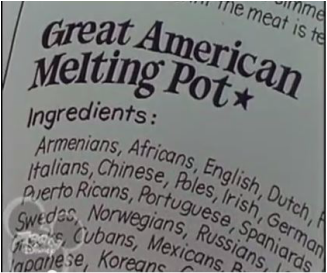 What does this imagery evoke in the American context? What does this imagery evoke in the American context?
Tags: culture, education, immigration/citizenship, multiculturalism, nationalism, race/ethnicity, american, cultural assimilation, melting pot, 00 to 05 mins
Year: 1976 Length: 3:20 Access: YouTube Summary: This episode of "The American Melting Pot" is from Schoolhouse Rock!, the popular animated and musical education series for children. While it sought to promote awareness of immigration and diversity, it also illustrates the concept of cultural assimilation and the ideology of the US as a melting pot. The song's chorus communicates "Lovely Lady Liberty / With her book of recipes / And the finest one she's got / Is the great American melting pot." The animation reveals her book of recipes (e.g. Irish Stew) from various immigrant groups, but also a recipe for "The Great American Melting Pot," with these ingredients: "Armenians, Africans, English, Dutch, Italians, Chinese, Poles ..." The concept of the melting pot is that these cultures have peacefully intermixed throughout American history, thus building and then becoming a part of a dominant culture of American values and customs—which continues to welcome immigrants that "melt" or assimilate into a unified mainstream American culture (Native American culture and its destruction are never mentioned). It's clear intention is to promote equality: "You simply melt right in / It doesn't matter what your skin / It doesn't matter where you're from / Or your religion, you jump right in / To the great American melting pot." But in an educational context, its ideological effect can be to obscure that race and religion both mattered at the time the series was aired in the 1970s, and that they continue to matter today. Proponents of multiculturalism have critiqued this concept and suggested new metaphors (e.g. salad bowl, cultural mosaic, or kaleidoscope) where different ethnic groups maintain their own cultural identities within a shared space. The video does, however, suggest a more nuanced notion of the melting pot when it states "How great to be an American / And something else as well" while it reveals a flag-waving grandmother's button that reads "Kiss me, I'm Polish." Thank you to Nicole Spitzer for recommending this clip! Submitted By: Paul Dean
3 Comments
 Notions of good, hard-working people are attached to white male farmers in this ad. Notions of good, hard-working people are attached to white male farmers in this ad.
Tags: culture, gender, marketing/brands, media, nationalism, organizations/occupations/work, race/ethnicity, religion, american dream, commercial, farming, hegemony, ideology, 00 to 05 mins
Year: 2013 Length: 2:02 Access: YouTube Summary: This commercial, which aired during the 2013 Superbowl, is a montage of pictures of farmers, their families, and their lifestyle. Throughout the whole ad there is a Paul Harvey speech, known as his “So God Made a Farmer” speech, that was delivered at a 1978 farmer’s convention. The ad connects the speech with the montage of the people in a way that shows how farming is part of American culture, very hard work, and is of great moral and religious value. The ad promotes the new Dodge Ram truck, although the truck only appears a limited number of times. It illustrates the hegemonic ideology of the American Dream in a gendered and racialized manner. In short, the American Dream is the belief that obtaining success and upward social mobility for your family comes through hard work. In the ad, the farmer is working hard because it is their duty to be a hard working American. As a political conservative, Harvey was a big believer in the American Dream and promoted rugged individualism throughout his radio shows, and reflect the meanings that Dodge is attributing to its brand of trucks. This ideology is hegemonic because people take this cultural attitude, and its uniquely American expression, for granted, thereby reinforcing societal power relations. It ilso illustrates gender ideology, which can be referred to as the attitude regarding the roles, rights, and responsibilities of men and women in society. In the traditional sense, the men work blue-collar jobs while the women take care of the household and children. The ad both reflects and reinforces this traditional gender ideology, with 6 females shown in the ad compared to 21 men. None of the women were shown doing the “dirty work” while many of the men showed were actually involved in acting on their farm duties. The second to last picture in the montage is of a young child staring off into the farm with a cowboy hat while Harvey narrates, “When his son says that he wants to spend his life doing what dad does, so God made a farmer,” which reinforces the notion of farming as a masculine activity. Finally, the vast majority of farmers in the clip are white. There is a single image of an African American male farmer, and a Hispanic woman and her son, but for the most part, the video links the notions of good, hard working moral people with white male farmers, and of course, people who drive Dodge trucks. Submitted By: Omar Mendez  This ad celebrates materialism and the American Dream. This ad celebrates materialism and the American Dream.
Tags: class, consumption/consumerism, culture, marketing/brands, marx/marxism, nationalism, theory, american dream, commercial, ideology, 00 to 05 mins
Year: 2014 Length: 1:02 Access: YouTube Summary: This Cadillac commercial starts with actor Neal McDoungh looking over his private, in-ground pool as he poses the question “Why do we work so hard? For this? For stuff?” He talks about why Americans don’t slack off like other countries, which take a whole month of vacation. He spouts a list of famous innovators, and asks if we think they took an entire month off? Nope, because they were busy being innovators, and living the American dream. The ad is exemplary of the hegemonic ideology of the American Dream. Ideology is a collection of shared beliefs and ideas for understanding the social world that explain and justify power or challenge social relations. In this commercial we see that the actor has achieved economic success. As he walks around his expensive house and material possessions, he discusses why it’s great to be a hard working, no vacation-taking American. McDoungh directly calls out our desire for all the “stuff” which aligns with the value our culture places on material things as a value of success. Then at the end of the commercial he directly ties together the concept that taking only two weeks off means we can have more stuff, enforcing the ideology that hard work will get you the things you want: “It’s pretty simple, you work hard, you create your own luck, and you gotta believe anything is possible.” Similar to a second Cadillac ad, the emphasis on "American" suggests that this idea is a uniquely American characteristic, even though upward mobility is more common in other developed countries. It is like other dominant ideologies that are reproduced throughout institutions (i.e. the media), and this particular ideology is hegemonic because for many Americans, this way of understanding our culture is taken-for-granted. It reproduces existing class relations because it suggests that material success is based upon our degree of effort, passion, and hard work (rather than our class background or other environmental factors), and that if we are not successful, then we accept that we only have ourselves to blame. After watching this ad, it is interesting to see this Ford commercial. It emphasizes local efforts, and parallels the format and style of the Cadillac ad (it really makes fun of the smugness of their competitor, Cadillac). Submitted By: Alexis Blaylock 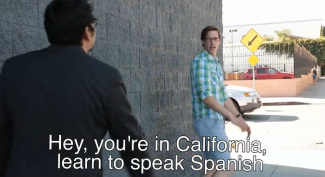 This humorous clip turns the table on whites. This humorous clip turns the table on whites. Tags: discourse/language, immigration/citizenship, inequality, nationalism, prejudice/discrimination, race/ethnicity, hispanic, microaggressions, whiteness, 00 to 05 mins Year: 2014 Length: 1:55 Access: YouTube Summary: This satirical video features a Hispanic male and female commenting to white individuals about white culture and norms. Some topics they address include: white food, white sports commentators, white standards of dress, white families, white names and pronunciation, beauty standards, and immigration status. They say things such as: "My nanny was white so I totally get it. I feel like I am part white because of my nanny"; "Is it true that white people all have small, quiet families? I wish I had that"; "You went to Princeton? Oh, you're white, that's how you got in." Like common stereotypes about Hispanics and other racial groups, the comments all imply that white culture is homogenous and that all white individuals experience their whiteness in the same way. It turns the table on the white respondents by implying that they are speaking as members of their race, which racial minorities are often expected to do. Perhaps the more fundamental challenge is that it forces white respondents (and viewers) to consider whiteness as a part of their identity, which is something that is not often experienced or commented upon by whites (this is an example of white privilege). Again, this is often not the case for racial minorities, whose racial identity cannot so easily be ignored because they continuously experience situations where others identify them by their racial group. White viewers might be encouraged to consider what it would feel like to experience these types of comments on a daily basis. In particular, it suggests various ways in which Hispanics experience microaggressions, or the “brief and commonplace daily verbal, behavioral, or environmental indignities, whether intentional or unintentional, that communicate hostile, derogatory, or negative racial slights and insults toward people of color” (Sue, et. al. 2007). The clip adopts a similar strategy as this other satirical video that addresses frequent stereotypical comments that Asian-Americans experience from white Americans. Submitted By: Alan Neustadtl 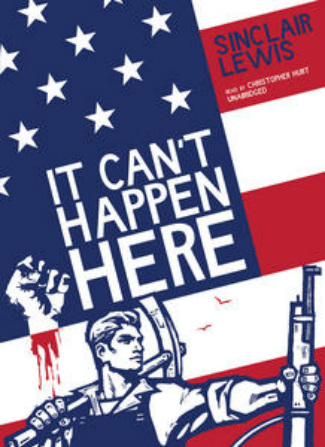 Film explores whether the US is immune to tyrannical rule. Film explores whether the US is immune to tyrannical rule. Tags: crime/law/deviance, government/the state, historical sociology, inequality, nationalism, politics/election/voting, dictatorship, domination, oligarchy, social construction of reality, tyranny, 61+ mins Year: 2013 Length: 94:23 Access: Top Documentary Films Summary: As stated on the film's website: "There are many perfect examples in our recent history which undoubtedly show that dictatorial regimes impose subjection, blackmail, servitude, intimidation, abuse, persecution and execution upon innocent people. However, many Americans are strongly convinced and assuredly assert that such a thing could never happen in the United States. But is this just desirous reasoning? Or, is there something essentially disparate about the United States that makes it resistant to the despotic abuse that has afflicted every other considerable empire in history? The primary step in scrutinizing the assertion that it can't happen here is to recognize and describe what "IT" is. Many people have distorted, almost comic-book-type, impression of dictatorship. In the real world autocracy has always crept in under the pretense of safeguarding the nation, defending the people, and establishing law and order. A dictator, in order to acquire and hold power, must demand the support of the people. An effective oppressor cannot publicly display malevolence and desire for power but must design his approach so as to persuade the people that his goals are righteous, that he wants honesty and fairness to abound, and that the most desirable way to make that true is to give him or her dominance and authority. Tyrannical governments develop by abusing people's fears - economic uncertainty, crime, foreign aggressors and so on and persuading the people that the quick-fix is for a political leader to be legally given absolute jurisdiction so he can shield the people from the wickedness of the world. This is always the pattern out of which autocracy is born. No matter how cruel or bloodthirsty regime becomes those in charge will persist to claim noble intentions and will dictate that an extreme government powers are required to protect the people and to create justice and order. Every time mankind has taken a step away from democracy and towards autocracy it was done in the name of defending the country and the people." Submitted By: Tom Sparhawk  This ad reinforces viewers' belief in the American Dream. This ad reinforces viewers' belief in the American Dream. Tags: class, consumption/consumerism, marketing/brands, marx/marxism, nationalism, theory, american dream, commercial, ideology, 00 to 05 mins Year: 2014 Length: 0:30 Access: YouTube Summary: Ideologies are sets of ideas and beliefs through which people make sense of the social world. Ideologies are always related to power, with dominant ideologies reinforcing existing power relations. The American Dream is a particularly powerful ideology that reinforces class relations by perpetuating the belief that anyone who works hard can be economically sucessful (despite the overwhelming evidence of how class inequality shapes economic outcomes). This car commercial illustrates this ideology with a discussion of the excellence that has come out American garages: "The Wright brothers started in a garage, Amazon started in a garage, Hewlett Packard started in a garage ... the Ramones started in a garage. My point? You never know what kind of greatness can come out of an American garage." It suggests that anyone can do great things from humble beginnings, a fundamental element of the American Dream. The emphasis on "American" suggests that this idea is a uniquely American characteristic, even though upward mobility is more common in other developed countries. The ad goes on to show a Cadillac literally and metaphorically emerging from an American garage, thereby using notions of the American Dream to appeal to consumers' aspirations and nationalistic pride. It is not only an attempt to sell both Cadillac cars and attach those meanings to its brand, but also reinforces viewers' sense of the American Dream as reality. However, this association begs the question: Who does the American Dream apply to? In reality the American dream is not for the poor, but for the rich. Furthermore, it is not just the corporations that utilize the American Dream to market products to society; politicians and public figures often utilize images of the American society to convince people to support public policy, similar to how it is being used in this car commercial. For a scathing critique of the American dream, see this clip from George Carlin. Submitted By: Kelsey Gallaher  SooJin Pate explains microaggressions SooJin Pate explains microaggressions Tags: discourse/language, education, immigration/citizenship, inequality, nationalism, prejudice/discrimination, race/ethnicity, social mvmts/social change/resistance, theory, microaggressions, subtitles/CC, 00 to 05 mins Year: 2013 Length: 5:06 Access: YouTube Summary: Microaggressions are something that happens every day, but which not many people really understand. This is a five-minute video about microaggressions featuring Professor SooJin Pate, who received her Ph.D. in American Studies at the University of Minnesota. In the video, she explains microaggressions with a couple of every day examples along with a personal anecdote, and then goes on to give advice for interrupting microaggressions. This is a great piece for helping students understand microaggressions and contextualize how they can interrupt them both as a microaggressor and a victim of microaggressions. Many students find SooJin Pate's radical approaches of kindness and activism to be an empowering way of understanding their role in achieving social justice. It is great both as an introduction to microaggressions, for students just becoming familiar with the topic; and also for students already familiar with concepts like Critical Race Theory and the Pedagogy of the Oppressed, as another perspective on the interruption of discrimination in their daily lives. Note that The Sociological Cinema has also explored the concept of microaggressions in an earlier post. Submitted By: Macalester College Department of Multicultural Life 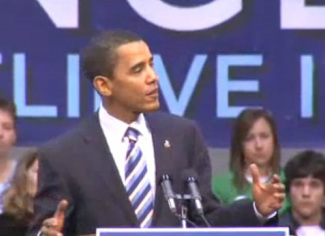 Obama urges Americans to move beyond issues of race. Obama urges Americans to move beyond issues of race. Tags: nationalism, race/ethnicity, theory, color-blindness, ideology, obama, 06 to 10 mins Year: 2008 Length: 6:14 Access: YouTube Summary: Racial ideologies are race-based frameworks for understanding the social world, which either challenge or reinforce the status quo of white privilege. In his book, Racism Without Racists (2013), Bonilla-Silva argues the dominant ideology of today is color-blindness, which views race as no longer important to determining social outcomes and, that by discussing race, we are treating it as if it is a real thing. As a result, we should move beyond race by ignoring it and being color-blind. The problem is that race does continue to shape social outcomes (e.g. in the labor market, wealth, education, interactions with police, and everyday encounters), and by ignoring this--or by being colorblind--we help perpetuate and reinforce the system of racial inequality. The power of this ideology is reflected in this early speech by Obama in March 2008. The speech came after the controversy of Jeremiah Wright, Obama's pastor whose racial remarks became highly scrutinized in national media. In the video here, Obama is encouraging viewers to ignore the issue of race and unite as Americans--to "move beyond these kinds of divisions." In short, he is promoting a color-blind society united through national identity. This is especially interesting in the context of Bonilla-Silva's book because in it, he predicts the future of race relations in the US by drawing upon the examples of Latin America. Amongst other factors, he notes that white supremacy in Latin American (e.g. Brazil) has been maintained through the myth of national unity, which claims that these countries have moved beyond racial divides and are united through national identity. In this speech, Obama makes similar calls to "bring the country together" as "Americans"; he states that "there is no Black America or white America, Asian America, Latino America; there is the United States of America" to great applause from the audience. In the book (Chapter 10), Bonilla-Silva notes the absence of gains made by Obama in regards to race, a topic that is not targeted in his social policies and is almost never addressed publicly (for an important exception, see his comments following the death of Trayvon Martin). In sum, Obama's speech is ideological because it helps to reinforce the system of white privilege; only by examining and discussing racial inequality can we begin to move beyond it. Submitted By: Paul Dean 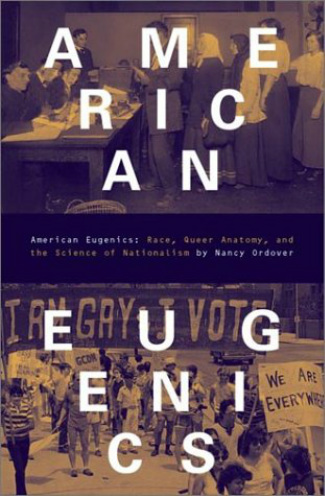 Eugenic thinking is woven into the fabric of American society Eugenic thinking is woven into the fabric of American society Tags: biology, bodies, class, crime/law/deviance, demography/population, disability, discourse/language, gender, health/medicine, immigration/citizenship, intersectionality, lgbtq, nationalism, prejudice/discrimination, race/ethnicity, science/technology, sex/sexuality, institutionalized discrimination, eugenics, subtitles/CC, 11 to 20 mins, 21 to 60 mins Year: 2012; 2013 Length: 15:05; 17:25 Access: YouTube (clip 1; clip 2) Summary: The eugenics movement has a long history in the United States. A popular misconception is that eugenic thinking and the associated practices were uniformly abandoned after the Third Reich's genocidal intentions were laid bare at the end of the Second World War. In point of fact, eugenic ideologies and practices have been recalcitrant features of American social institutions right up until the present day. In her book American Eugenics: Race, Queer Anatomy, and the Science of Nationalism, Nancy Ordover remarks on the resiliency of the ideology, "Eugenics..is a scavenger ideology, exploiting and reinforcing anxieties over race, gender, sexuality, and class and bringing them into the service of nationalism, white supremacy, and heterosexism." In earlier decades eugenicists could openly discuss stemming the "overflow" of immigration, as an effort to "dry up...the streams that feed the torrent of defective and degenerate protoplasm." The language of eugenics would eventually change, but the core ideas have remained; socially deviant groups and socially undesirable conditions are seen by eugenicists as biologically determined. The above clips are news stories, which draw attention to two recent manifestations of eugenics policy. The first clip chronicles the experience of an African American woman who was legally sterilized in the late 1960s in North Carolina after giving birth to her first son. The clip reports that between 1929 and 1974 approximately 7,600 North Carolinians were sterilized for a host of dubious reasons, from "feeble-mindedness" to "promiscuity." But while North Carolina's victims included men, women, and children, Ordover's research points out that the victims were overwhelmingly women and African American (by 1964 African Americans composed 65% of all women sterilized in the state). The first clip, then, is an example of how eugenics became institutionalized with the force of law, but the second news clip examines a case of institutionalized eugenics in California, which existed without the explicit consent of law. In 1909 California became the third state to pass a compulsory sterilization law, allowing prisons and other institutions to sterilize "moral degenerates" and "sexual perverts showing hereditary degeneracy." By 1979, when the law was finally repealed, the state had already sterilized as many as 20,000 people, or about one-third of the total number of such victims throughout the United States. One learns from the news clip that between 2006 and 2010, 148 women were sterilized by doctors who continued to be guided by the precepts of their eugenic ideology. Submitted By: Lester Andrist  An Asian woman gets asked, "Where are you really from?" An Asian woman gets asked, "Where are you really from?" Tags: discourse/language, immigration/citizenship, inequality, nationalism, prejudice/discrimination, race/ethnicity, microaggression, perpetual foreigner syndrome, racism, substantive citizenship, white privilege, subtitles/CC, 00 to 05 mins Year: 2013 Length: 2:20 Access: YouTube Summary: In the U.S. people are often asked where they are from, but Asians, Latinos and other people of color often share the distinction of being confronted with a follow up question: "No, I mean where are you really from?" It is useful to examine what this common exchange reveals about how whites draw on race as a means of navigating and reasserting symbolic boundaries between insiders and outsiders, or between substantive citizens and non-citizens. This ridiculous scenario is humorously reenacted in the above comedy sketch, which features an Asian woman sharing a casual conversation with a white man. The man asks her where she is from, but after the woman explains she is from San Diego, the man becomes confused and attempts to clarify, "No, I mean, where are you really from?" His awkward questioning about the woman's "true" origin is a symptom of what law professor Frank H. Wu refers to as the "the perpetual foreigner syndrome." As Wu points out, when a person asks, "why aren't you married?" they are clearly signaling a measure of disapproval, and similarly, the question, "Where are you really from?" communicates something more than a curiosity about one's place of birth (see also, "My, you speak English so well!"). The question constitutes an effort to catalog a person on the basis of a perceived racial difference, but the effect of asking the question is exclusion, and as such, it can be understood as a microaggression, a term that refers to the “brief and commonplace daily verbal, behavioral, or environmental indignities, whether intentional or unintentional, that communicate hostile, derogatory, or negative racial slights and insults toward people of color” (Sue, et. al. 2007). The comedy sketch also serves as a means of broaching an important discussion about how this type of symbolic exclusion is part and parcel of a much broader historical pattern. To name just one particularly vulgar example, during the Second World War, Japanese Americans living on the U.S. West Coast were forced from their homes and relocated to concentration camps. Irrespective of whether they immigrated or were born in the United States, high ranking military officials and state representatives joined media columnists in amplifying the viewpoint that Japanese Americans were perpetual foreigners who could not be trusted. Despite living in the United States their entire lives, many assumed Japanese Americans were not really Americans. Submitted By: Lester Andrist |
Tags
All
.
Got any videos?
Are you finding useful videos for your classes? Do you have good videos you use in your own classes? Please consider submitting your videos here and helping us build our database!
|
 RSS Feed
RSS Feed
